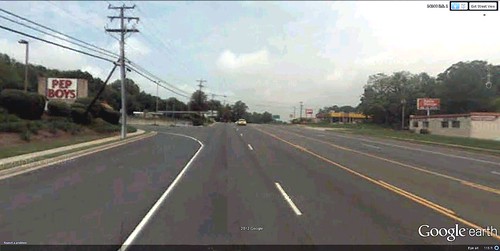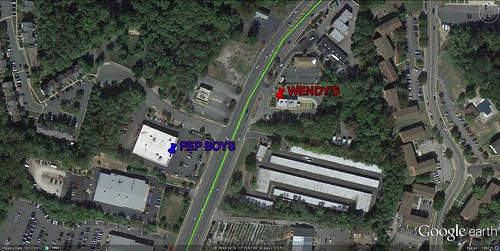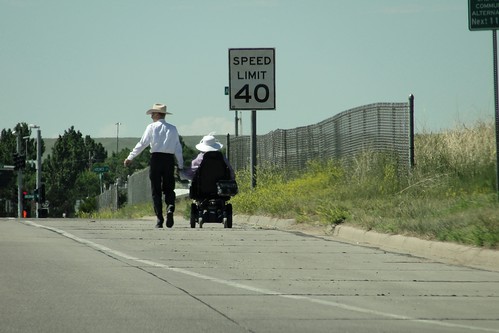"In much of America, walking – that most basic and human method of
movement, and the one most important to our health – is all but
impossible. Maybe not literally impossible, but inconvenient at best,
and tragically dangerous way too often. Chances are that, no
matter where we are from, the stretches of road shown in the photos
accompanying this article look somewhat familiar. They might as well
be labeled Anywhere, USA. The one above is from Denver. The Google
Earth image below shows the US Route 1 corridor in Woodbridge,
Virginia, about 25 miles south of downtown Washington, DC. I'm going
to spend some time on Woodbridge today because of some incidents that
have occurred there.

Home
to the Potomac Mills discount mega-mall and not far from the Quantico
Marine Corps base, Woodbridge is a diverse “census-designated place and
magisterial district” whose population is 42 percent white, 28 percent
black, and 32 percent Hispanic. It was mostly farms and light
industrial complexes until the 1980s when it began to be more
suburbanized. What you see in the satellite view are, among other
things, several auto dealerships and automobile service facilities, some
single-family homes, some apartments, a trailer park, and a
self-storage facility; all seem sort of plopped down by happenstance.
What
you don’t see are any but the crudest accommodations for walking.
This particular part of Woodbridge is a place for being either indoors
or in a motor vehicle. If you were, say, an employee at the Pep Boys
auto parts store, didn’t have a car on a given day, and wanted to grab a
sandwich for lunch at Wendy’s
right across the street, you’d
have to walk nearly a mile, round trip, to cross the road with the
benefit of a traffic signal. Even then, half your trip would have no
sidewalk.

What
many people with limited time would understandably do in that
situation, instead, is attempt to cross the road using the shortest and
most direct route between Pep Boys and Wendy’s, and hope their
instincts and powers of observation would enable them to do so without
getting hit. Some people do exactly that, without consequence.
But
other pedestrians aren’t so lucky. If they do get hit by a motor
vehicle, under Virginia law the pedestrian is at fault for “interfering
with traffic.” Cars come first in the eyes of the law, and anyone who
fails to respect that axiom takes chances in more ways than one.
I
mention all this because it’s more or less what actually happens on
this stretch of Route 1. Videographer Jay Mallin has made a video
about it. It’s at the bottom of this post, it’s good, and you should
watch it. But first allow me to take a bit more of your time by setting
the context.

I was reminded of this story while browsing some articles I had saved on my Google Reader, one of which was
“How pedestrians interfere with traffic,” written by the astute and prolific David Alpert on the
Greater Greater Washington
blog. David was impressed with Mallin’s video, which tells the story
of two men who were hit by motor vehicles while trying to cross the road
in separate incidents near the section of Route 1 that I marked. (You
can see the Wendy’s in the background of the video.) Both pedestrians
were evacuated to the hospital, and both were charged by police with
interfering with traffic. The drivers were not charged.
Some
would-be pedestrians in similar circumstances suffer far worse
consequences, unfortunately. As some readers may remember, in 2011 a
working single mother named Raquel Nelson was convicted of homicide
after her four-year-old son was killed while both were trying to cross a
busy road in suburban Atlanta. They were on their way home, carrying
groceries after getting off the bus at a stop with no convenient
crosswalk.
As I wrote then,
whatever Nelson’s legal culpability, I find it shocking that Atlanta
officials chose to exercise their discretion to prosecute her for
homicide under those circumstances. At least in that case the driver,
who had been drinking and taking painkillers, and who had fled the
scene, was also charged.
The nonprofit advocacy coalition
Transportation for America (NRDC is a member) has found that, from 2000
through 2009, more than 47,700 pedestrians were killed in the United
States. This is the equivalent of a jumbo jet full of passengers
crashing roughly every month. On top of that, more than 688,000
pedestrians were injured over the decade, a number equivalent to a
pedestrian being struck by a car or truck
every 7 minutes.

Even
if you’re not killed or injured, you can't help but find much of
suburban America inhospitable to walking. Just this week,
Ben Ross reported in Greater Greater Washington
that it took him eight and a half minutes to cross legally to the other
side of a Maryland street, traversing 28 traffic lanes along the way.
Two pedestrians had been severely injured at the same intersection
earlier this month. Is it any wonder that, in the US, those with a
choice choose to drive even the shortest of distances?
In 1973,
sixty percent of American kids walked to school; by 2006, that portion
had dropped to a paltry 13 percent. As a sign that times have changed,
a story surfaced a few years ago
that a mom and her 12-year-old son in Saratoga Springs, New York, were
actually forbidden to ride bikes together to the son’s school, even on a
bike path separated from car traffic. On the other side of the
country, Laguna Beach
refused to join
over 400 California communities participating in International Walk to
School Day, a supervised event, because “there are few sidewalks,
winding roads with blind corners and a considerable distance for our
students to travel and we cannot endorse walking or biking to school.”
In Montgomery County, Maryland, the local Department of Transportation
refused parents’ request for a crosswalk
linking a large residential development to an elementary school right
across the street because “the safest way is to have them bused to
school” instead. If walking is no longer safe and convenient in
relatively upscale Saratoga Springs and Laguna Beach, how are we going
to fix a suburbanizing place whose residents may struggle to afford cars
and arguably are even more in need of good alternatives?

Jeff Speck’s current book
Walkable City provides some answers, but they aren’t going to work everywhere. His
“ten steps of walkability”
to create urban environments more conducive to foot travel include such
effective measures as placing more housing downtown, restricting free
parking, and coordinating transit with nearby land uses. If we do
these things in Boise or Houston or Greensboro or even Bakersfield, it
is likely that we will, indeed, make the city more walkable.
But
can we have a walkable city where we don’t have a city in the first
place? What if the location is just a “census-designated place” with a
bunch of uncoordinated and unplanned properties that somehow ended up
near each other along a high-speed road? The stretch of Route 1 in
Woodbridge is not remotely ready for sophisticated measures.
I
suppose one answer is that, as the economy allows new businesses and
homes to be built in and around the bad stuff, we gradually can make
the newer land uses better and more “walk-ready” over time, so that the
place can function better for pedestrians when the good stuff reaches
critical mass. That might take a while, though, because many of these
places are not the kind of prosperous communities where change can occur
rapidly and with the degree of investment necessary to do it right.
Maybe
Jeff could write a sort of prequel to his book (easy for me to say),
with ten preliminary steps to get a mess of a place such as Route 1 in
Woodbridge ready for the ten steps of walkability featured in his
current one.

Whatever
the right approach, it matters: a lot of places in America are a lot
like Woodbridge. And, if we don’t start exercising more, including by
walking, the prospects for our collective health are daunting. The
single most alarming public health trend in the United States today is
the dramatic rise in overweight and obesity, bringing serious risks of heart disease, diabetes and other consequences leading to life impairment and premature death.
While
these are complex challenges, and there are many factors at play, our
country’s sedentary lifestyle is an important one. In a massive study
of half a million residents of Salt Lake County,
researchers at the University of Utah found
that an average-sized man weighed 10 pounds less if he lived in a
walkable neighborhood – “those that are more densely populated, designed
to be more friendly to pedestrians and have a range of destinations
for pedestrians” – versus a less walkable one. A woman of average
size weighed six pounds less.
Other research has found
that men and women age 50–71 who took a brisk walk nearly every day had
a 27 percent reduced death rate compared to non-exercisers.
This isn't the first time I have written on this subject, and it certainly won't be the last. It's too important to ignore.
Now, as promised, here’s the video:
Kaid Benfield is director of sustainable communities at The Natural Resources Defense Council in Washington, DC. This blog also appeared on NRDC Switchboard where Kaid writes (almost) daily about community, development, and the environment.
For more in-depth coverage:
•
Subscribe to
Better! Cities & Towns to read all of the articles (print+online) on implementation of greener, stronger, cities and towns.
• Get the
December 2012
issue. Topics: Sprawl versus walkable: Housing study, Nashville code
creates value, Wake up call from Sandy, Downtown Columbia, Smart
growth at the polls, Buffalo code reform, Housing and driving
costs, Comparing new urban and conventional development,
NorthWest Crossing, Alexander's The Battle for the Life and
Beauty of the Earth
• Get
New Urbanism: Best Practices Guide,
packed with more than 800 informative photos, plans, tables, and other
illustrations, this book is the best single guide
to implementing better cities and towns".
Fonte e imagens:
http://bettercities.net/news-opinion/blogs/kaid-benfield/19343/disturbing-and-sometimes-tragic-challenge-walking-america 



























